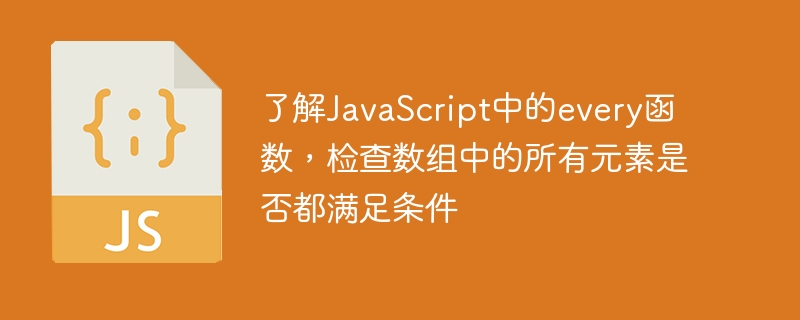

Understand the every function in JavaScript, check whether all elements in the array meet the conditions, you need specific code examples
In JavaScript development, you often encounter the need Checks whether all elements in an array meet a certain condition. In order to facilitate this operation, JavaScript provides a very convenient function, the every function. This article will introduce the use of every function in detail and give specific code examples.
Every function is a method of JavaScript array object. It is used to check whether each element in the array meets the specified conditions. The every function returns true if all elements in the array meet the condition; if at least one element does not meet the condition, it returns false.
The following is the basic syntax of the every function:
array.every(callback[, thisArg])
Among them, array is the array object to call the every function; callback is A callback function used to check elements in the array; thisArg is an optional parameter used to specify the this pointer in the callback function.
Next, we demonstrate the use of every function through specific code examples.
Suppose we have an array of numbers, and we need to check whether all elements in this array are greater than 10. The following is the code implemented using the every function:
const numbers = [12, 15, 18, 21, 24];
const result = numbers.every(function(number) {
return number > 10;
});
console.log(result); // 输出:trueIn the above code, we define an array named numbers, which contains five numbers. Then, we use the every function to check whether every element in this array is greater than 10. The parameter number in the callback function represents each element in the array. We compare it with 10. If it is greater than 10, it returns true, otherwise it returns false. Finally, we output the result of the check to the console, with the expected value being true.
Let’s look at another example. Suppose we have a string array, and we need to check whether all elements in this array are words starting with an uppercase letter. The following is the code implemented using the every function:
const words = ["Apple", "Banana", "Cherry", "Dates"];
const result = words.every(function(word) {
return /^[A-Z]/.test(word);
});
console.log(result); // 输出:trueIn the above code, we define an array named words, which contains four strings. Then, we use the every function to check whether each element in this array is a word starting with an uppercase letter. The parameter word in the callback function represents each element in the array, and we use regular expressions to check whether each word meets the conditions. Finally, we output the result of the check to the console, with the expected value being true.
We can see from the above code example that the every function is very convenient to help us check whether all elements in the array meet the conditions. By passing different callback functions, we can flexibly adapt to various inspection needs.
To summarize, this article introduces the every function in JavaScript, which is used to check whether all elements in the array meet the conditions. We have given specific code examples, hoping that readers can better understand the use of every function through these examples and flexibly apply it in actual development.
The above is the detailed content of Understand the every function in JavaScript to check whether all elements in the array meet the conditions. For more information, please follow other related articles on the PHP Chinese website!
